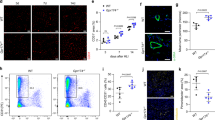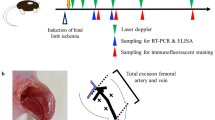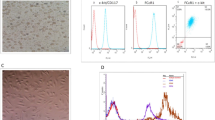Abstract
The establishment of functional and stable vascular networks is essential for angiogenic therapy. Here we report that a combination of two angiogenic factors, platelet-derived growth factor (PDGF)-BB and fibroblast growth factor (FGF)-2, synergistically induces vascular networks, which remain stable for more than a year even after depletion of angiogenic factors. In both rat and rabbit ischemic hind limb models, PDGF-BB and FGF-2 together markedly stimulated collateral arteriogenesis after ligation of the femoral artery, with a significant increase in vascularization and improvement in paw blood flow. A possible mechanism of angiogenic synergism between PDGF-BB and FGF-2 involves upregulation of the expression of PDGF receptor (PDGFR)-α and PDGFR-β by FGF-2 in newly formed blood vessels. Our data show that a specific combination of angiogenic factors establishes functional and stable vascular networks, and provides guidance for the ongoing clinical trials of angiogenic factors for the treatment of ischemic diseases.
This is a preview of subscription content, access via your institution
Access options
Subscribe to this journal
Receive 12 print issues and online access
$209.00 per year
only $17.42 per issue
Buy this article
- Purchase on Springer Link
- Instant access to full article PDF
Prices may be subject to local taxes which are calculated during checkout






Similar content being viewed by others
References
Folkman, J. Seminars in Medicine of the Beth Israel Hospital, Boston. Clinical applications of research on angiogenesis. N. Engl. J. Med. 333, 1757–1763 (1995).
Hanahan, D. & Folkman, J. Patterns and emerging mechanisms of the angiogenic switch during tumorigenesis. Cell 86, 353–364 (1996).
Zetter, B.R. Hold that line. Angiomotin regulates endothelial cell motility. J. Cell Biol. 152, F35–F36 (2001).
Dvorak, H.F. VPF/VEGF and the angiogenic response. Semin. Perinatol. 24, 75–78 (2000).
Freedman, S.B. & Isner, J.M. Therapeutic angiogenesis for coronary artery disease. Ann. Intern. Med. 136, 54–71 (2002).
Isner, J.M. Myocardial gene therapy. Nature 415, 234–239 (2002).
Waltenberger, J. Modulation of growth factor action: implications for the treatment of cardiovascular diseases. Circulation 96, 4083–4094 (1997).
Carmeliet, P. VEGF gene therapy: stimulating angiogenesis or angioma-genesis? Nat. Med. 6, 1102–1103 (2000).
Ferrara, N. & Alitalo, K. Clinical applications of angiogenic growth factors and their inhibitors. Nat. Med. 5, 1359–1364 (1999).
Yancopoulos, G.D. et al. Vascular-specific growth factors and blood vessel formation. Nature 407, 242–248 (2000).
Epstein, S.E., Kornowski, R., Fuchs, S. & Dvorak, H.F. Angiogenesis therapy: amidst the hype, the neglected potential for serious side effects. Circulation 104, 115–119 (2001).
Hendel, R.C. et al. Effect of intracoronary recombinant human vascular endothelial growth factor on myocardial perfusion: evidence for a dose-dependent effect. Circulation 101, 118–121 (2000).
Celletti, F.L. et al. Vascular endothelial growth factor enhances atherosclerotic plaque progression. Nat. Med. 7, 425–429 (2001).
Lee, R.J. et al. VEGF gene delivery to myocardium: deleterious effects of unregulated expression. Circulation 102, 898–901 (2000).
Ferrara, N. VEGF and the quest for tumour angiogenesis factors. Nat. Rev. Cancer 2, 795–803 (2002).
Senger, D.R. et al. Tumor cells secrete a vascular permeability factor that promotes accumulation of ascites fluid. Science 219, 983–985 (1983).
Shing, Y. et al. Heparin affinity: purification of a tumor-derived capillary endothelial cell growth factor. Science 223, 1296–1299 (1984).
Ataliotis, P. & Mercola, M. Distribution and functions of platelet-derived growth factors and their receptors during embryogenesis. Int. Rev. Cytol. 172, 95–127 (1997).
Holmgren, L., Claesson-Welsh, L., Heldin, C.H. & Ohlsson, R. The expression of PDGF α- and β-receptors in subpopulations of PDGF-producing cells implicates autocrine stimulatory loops in the control of proliferation in cytotrophoblasts that have invaded the maternal endometrium. Growth Factors 6, 219–231 (1992).
Lindahl, P., Johansson, B.R., Leveen, P. & Betsholtz, C. Pericyte loss and microaneurysm formation in PDGF-B-deficient mice. Science 277, 242–245 (1997).
Carmeliet, P. & Conway, E.M. Growing better blood vessels. Nat. Biotechnol. 19, 1019–1020 (2001).
Richardson, T.P., Peters, M.C., Ennett, A.B. & Mooney, D.J. Polymeric system for dual growth factor delivery. Nat. Biotechnol. 19, 1029–1034 (2001).
Yarden, Y. et al. Structure of the receptor for platelet-derived growth factor helps define a family of closely related growth factor receptors. Nature 323, 226–232 (1986).
Simons, M. et al. Pharmacological treatment of coronary artery disease with recombinant fibroblast growth factor-2: double-blind, randomized, controlled clinical trial. Circulation 105, 788–793 (2002).
Omura, T., Heldin, C.H. & Ostman, A. Immunoglobulin-like domain 4-mediated receptor-receptor interactions contribute to platelet-derived growth factor-induced receptor dimerization. J. Biol. Chem. 272, 12676–12682 (1997).
Cao, Y. et al. Vascular endothelial growth factor C induces angiogenesis in vivo. Proc. Natl. Acad. Sci. USA 95, 14389–14394 (1998).
Passaniti, A. et al. Stimulation of human prostatic carcinoma tumor growth in athymic mice and control of migration in culture by extracellular matrix. Int. J. Cancer 51, 318–324 (1992).
Seifert, F.C., Banker, M., Lane, B., Bagge, U. & Anagnostopoulos, C.E. An evaluation of resting arterial ischemia models in the rat hind limb. J. Cardiovasc. Surg. (Torino) 26, 502–508 (1985).
Essex, T.J. & Byrne, P.O. A laser Doppler scanner for imaging blood flow in skin. J. Biomed. Eng. 13, 189–194 (1991).
Wang, C., Kelly, J., Bowen-Pope, D.F. & Stiles, C.D. Retinoic acid promotes transcription of the platelet-derived growth factor α-receptor gene. Mol. Cell Biol. 10, 6781–6784 (1990).
Acknowledgements
We thank B. Heilborn for technical assistance. This work is supported by research grants from the Human Frontier Science Program, the Swedish Research Council, the Swedish Heart and Lung Foundation, the Swedish Cancer Foundation, the Karolinska Institute Foundation and the Åke Wibergs Foundation. Y.C. is supported by the Swedish Research Council.
Author information
Authors and Affiliations
Corresponding author
Ethics declarations
Competing interests
The authors declare no competing financial interests.
Supplementary information
Rights and permissions
About this article
Cite this article
Cao, R., Bråkenhielm, E., Pawliuk, R. et al. Angiogenic synergism, vascular stability and improvement of hind-limb ischemia by a combination of PDGF-BB and FGF-2. Nat Med 9, 604–613 (2003). https://doi.org/10.1038/nm848
Received:
Accepted:
Published:
Issue Date:
DOI: https://doi.org/10.1038/nm848
This article is cited by
-
Transmembrane stem factor nanodiscs enhanced revascularization in a hind limb ischemia model in diabetic, hyperlipidemic rabbits
Scientific Reports (2024)
-
The Regenerative Microenvironment of the Tissue Engineering for Urethral Strictures
Stem Cell Reviews and Reports (2024)
-
Safety and tolerability of intravitreal umedaptanib pegol (anti-FGF2) for neovascular age-related macular degeneration (nAMD): a phase 1, open-label study
Eye (2023)
-
Targeting angiogenesis in oncology, ophthalmology and beyond
Nature Reviews Drug Discovery (2023)
-
Bacteria-engineered porous sponge for hemostasis and vascularization
Journal of Nanobiotechnology (2022)



